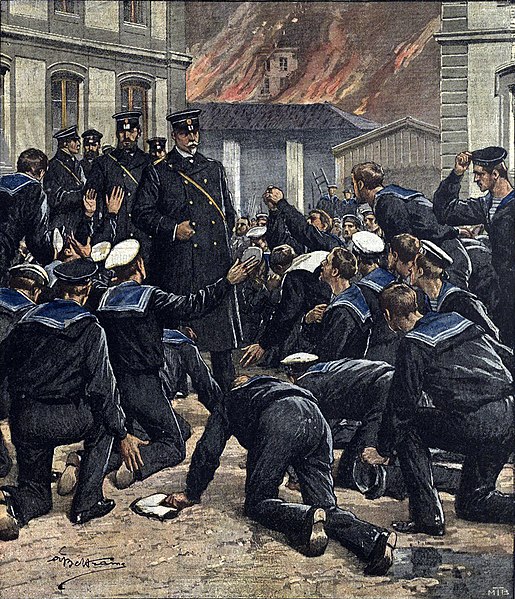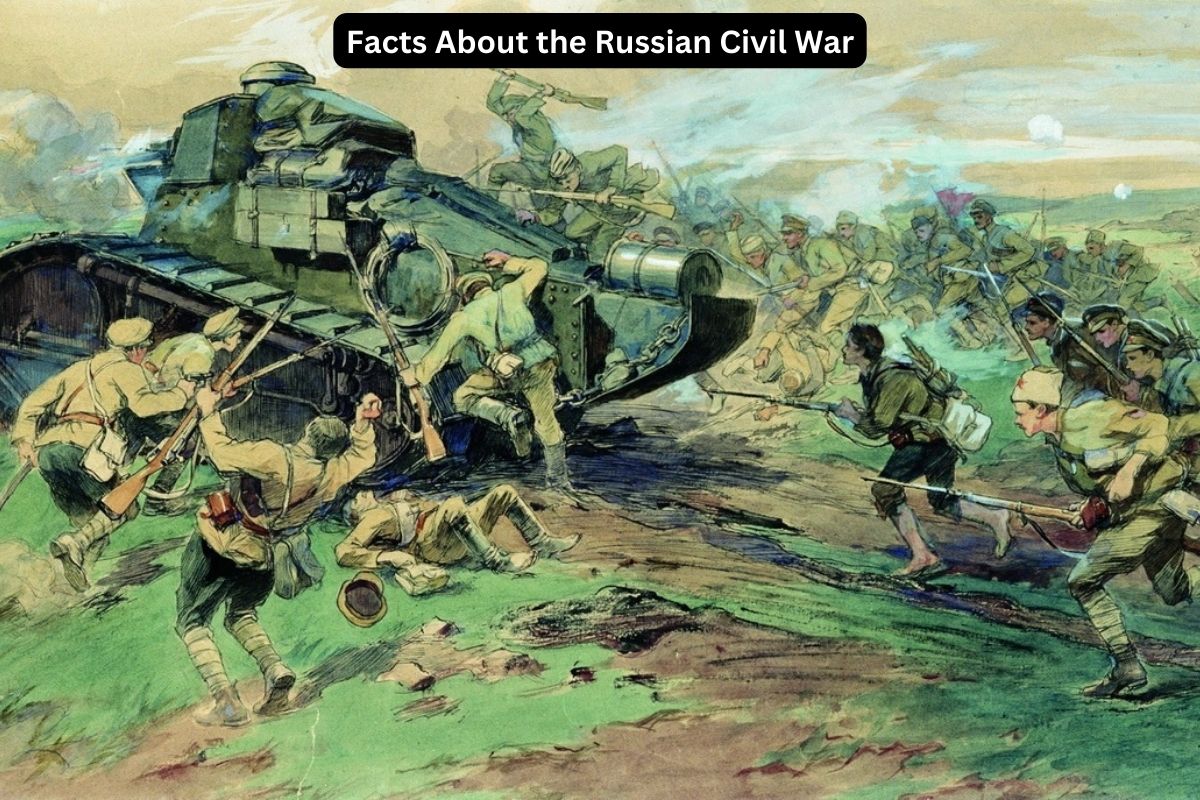The Russian Civil War, a pivotal and tumultuous chapter in Russian history, unfolded against the backdrop of the 1917 Russian Revolution and its aftermath.
This conflict, which raged from 1917 to 1922, involved a complex web of political, ideological, and social forces vying for control over the future direction of Russia.
From the clash between the Bolshevik Red Army and the diverse array of anti-Bolshevik factions to the intervention of foreign powers and the implementation of draconian policies such as War Communism, the Russian Civil War left an indelible mark on Russian society and shaped the course of 20th-century history.
In this comprehensive overview, we delve into the origins, key actors, major events, and lasting legacies of the Russian Civil War, shedding light on its multifaceted dynamics and enduring significance.
Russian Civil War Facts
1. Originated from power struggles after the 1917 Russian Revolution
The Russian Civil War stemmed from the aftermath of the Russian Revolution of 1917. Following the overthrow of the Tsarist autocracy, power struggles ensued among various factions vying for control over the newly formed Russian state.
Also Read: Timeline of the Russian Civil War
These factions included the Bolsheviks (Communists), who sought to establish a socialist regime, as well as other groups such as liberal democrats, socialists, and monarchists, each with their own vision for Russia’s future.

2. Red Army (Bolsheviks) vs. White Army (monarchists, liberals, etc.)
The conflict primarily pitted the Red Army, composed of Bolshevik supporters and revolutionary forces, against the White Army, which consisted of a disparate coalition of anti-Bolshevik factions.
The White Army encompassed a broad spectrum of political ideologies, including monarchists loyal to the deposed Romanov dynasty, liberals who favored parliamentary democracy, conservative factions, and military officers opposed to Bolshevik rule.
Despite their ideological differences, the common goal of the White Army was to overthrow the Bolshevik government.
3. Foreign intervention by UK, France, Japan, and US on behalf of White Army
The Russian Civil War saw significant foreign intervention from various international powers sympathetic to the anti-Bolshevik cause. Countries such as the United Kingdom, France, Japan, and the United States provided military assistance, supplies, and even troops to support the White Army in its struggle against the Bolsheviks.
Also Read: Russian Revolution Timeline
These foreign interventions were motivated by a combination of factors, including a desire to restore stability in Russia, counter the spread of communism, and safeguard their own strategic interests in the region. The presence of foreign forces further complicated the dynamics of the civil war and intensified the conflict.
4. Fought across territories of former Russian Empire
The Russian Civil War was not confined to the territory of Russia alone but also engulfed vast regions that were part of the former Russian Empire. The conflict spread across territories such as Ukraine, Belarus, the Caucasus, Central Asia, and the Baltic states.
This expansive geographical scope transformed the civil war into a multi-front conflict, with battles raging across diverse landscapes, from the urban centers of Moscow and St. Petersburg to the rural expanses of Siberia and the Caucasus Mountains.

5. War Communism policy introduced by Lenin to support Red Army
In response to the exigencies of war, the Bolshevik government under Vladimir Lenin implemented a policy known as War Communism.
This policy involved the nationalization of industry, centralization of economic control, and strict measures aimed at mobilizing resources for the war effort. Under War Communism, the state assumed control over key sectors of the economy, including factories, mines, and transportation networks.
Grain requisitioning and forced labor were employed to ensure the supply of essential goods and materials to support the Red Army and sustain the Bolshevik regime.
While War Communism helped bolster the Bolshevik war effort, it also led to widespread hardship, economic dislocation, and popular discontent among peasants and workers.
6. Atrocities and terror committed by both sides
The Russian Civil War was marked by widespread violence, atrocities, and terror perpetrated by both sides. The brutality of the conflict extended to civilians, who often found themselves caught in the crossfire or targeted by reprisals from warring factions.
Mass executions, massacres, and pogroms were carried out by both the Red Army and the White Army, as well as by various paramilitary groups and irregular forces aligned with each side.
The use of terror tactics, including summary executions, torture, and political repression, was employed to intimidate opponents, suppress dissent, and maintain discipline within the ranks.
The scale of violence and human suffering during the civil war was staggering, leaving a profound and enduring legacy of trauma and resentment in its wake.

7. Allied powers gradually withdrew from intervention
As the Russian Civil War progressed, the enthusiasm among Allied powers for intervening in Russia waned. The end of World War I in 1918 and the subsequent onset of post-war reconstruction efforts diverted attention and resources away from the Russian theater.
Moreover, mounting casualties, logistical challenges, and domestic opposition to foreign intervention contributed to the decision by many Allied governments to withdraw their troops from Russian territory.
By 1920, most foreign forces had exited Russia, leaving the Bolsheviks and the White Army to continue their struggle largely without external military support.
8. Bolshevik victory led to the establishment of the Soviet Union in 1922
The Russian Civil War concluded with a decisive victory for the Bolsheviks and the establishment of a communist state under Bolshevik leadership. The Red Army, bolstered by its organizational cohesion, ideological commitment, and control over key industrial centers, succeeded in defeating the disparate and often disunited forces of the White Army.
By 1922, the Bolsheviks had consolidated their control over Russia and neighboring territories, leading to the formation of the Soviet Union. The defeat of the White Army marked the end of significant organized opposition to Bolshevik rule and paved the way for the establishment of a one-party socialist state.

9. Legacy: Bolsheviks’ grip on power and the establishment of communism
The Russian Civil War had profound and far-reaching consequences for Russia and the world. The Bolshevik victory established communism as the dominant political ideology in Russia and set the stage for the creation of a totalitarian regime under the leadership of figures such as Vladimir Lenin and Joseph Stalin.
The establishment of the Soviet Union transformed the geopolitical landscape of the 20th century, shaping international relations, ideology, and conflict dynamics for decades to come.
The legacy of the civil war also left deep scars on Russian society, contributing to a legacy of political repression, economic stagnation, and social upheaval that persisted throughout much of the Soviet era.
10. Heavy human cost with casualties ranging from hundreds of thousands to over 10 million
The Civil War exacted a heavy toll in terms of human lives, with casualties numbering in the millions. Estimates of the total death toll vary widely, ranging from several hundred thousand to over 10 million people.
The conflict brought widespread devastation, suffering, and displacement to Russian society, leading to famine, disease, and economic collapse.
The human cost of the Russian civil war, including the loss of civilian lives, combatants, and refugees, remains a poignant reminder of the violence and upheaval that accompanied this tumultuous period in Russian history.
